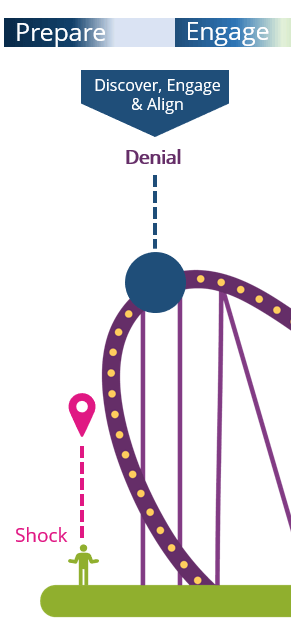Rethinking your Change
We already know that projects are most likely to fail when the key component of your organisation is overlooked – namely, investing in your people, not just your software. In our last article we explored the Kubler-Ross Change Curve and what it actually means to “manage change” in order to achieve a quicker time to integration and embedding of the new, more modern processes and productivity you are looking to achieve.
In our articles so far, we’ve also looked at the need to align the four key milestones when approaching any change: Prepare, Engage, Involve and Embed.
Within those four milestones are strategic processes which are easy to follow and straightforward to determine in the context of your organisation. These processes are absolutely essential to achieving a return on investment and ensuring you don’t fall foul of that most usual tactic – common sense not necessarily being common practice.
So, what can we do to overturn that and rethink the way that we approach change management and development of our people? How can we ensure that the actual, real scenarios found in the change curve are overcome?
The first milestone is (as often is the way) the most important – it dictates your direction and metaphorically plots in the project postcode on your implementation Sat Nav. “Fail to prepare, then prepare to fail”, as the saying goes.
Rethinking your Change: Prepare
Alright, yes – we know. Always write a list!
I imagine that is what many of you are saying, but other than the weekly shop, how many of us actually do that in practice? We write huge, massive reams of lists in regard to the requirements demanded of our software, but how big is that list when you look at preparing your staff to come on that rollercoaster with you and be able to produce the desired effect at the end?
You get out what you put in.
As we have seen from the change curve, the first stage which your team will go through is shock and then denial. And that’s where it is key your response is to discover, engage and align. But you can get ahead of that by really getting into the mindset of your staff and thinking about how you are going to approach your team to discuss the project and get their input. What technique is going to work best in making them part of it and ensure they don’t automatically go against it, ignore it and/or deny that it’s happening or anything to do with them?
Before you engage with your team, you need to know how you’re actually going to do just that!

There’s a very simple “shopping list” of quick, straightforward tasks we can all undertake before approaching any change or engagement with our teams. It doesn’t have to be related to implementation, but as Digital Transformation experts, that is of course where our heart and our knowledge is.
Here’s a glimpse of the shopping list you can use as a directional map for what you need to do here.
It creates the building blocks of your approach and your collaboration with the people who actually use the software day to day. The people who will be getting you value for money – if you don’t do it right with your people, you may as well have bought a very, very expensive vase, popped it in the middle of the office and watched as no one ever brought you flowers. No smelling the roses if you don’t get this bit right!
Evaluate your context – Why are you actually doing this? What were the reasons behind your project? Improved productivity? Best practice models? Higher revenue generation with lower overheads? Scalabilty? End User experience? Growth? Technology driver? Whatever your reasons, understand the real nature of what you are doing and why you are doing it and don’t miss the other benefits that you will naturally gain from the change you are about to embark on.
Determine aspects of your context that hinder your change – Have you canvassed the team to ask what they think – where are the pitfalls of their processes and productivity, what goes wrong, what goes right? What are their needs in terms of what you get out of any system? Have they been crying out for a new system, or are they clinging to their machines as if you’re trying to take away the one thing that keeps them steady and sane in their working lives? If you are trying to get more productivity out of the system, are you going to be asking for more productivity from your team or less – is the system meant to do more with less input or do you want it to expand what you can do and therefore consequently need more input from your staff to achieve a wider scope of MI? Look at all the aspects of your context and then flip them on their head and see whether that part of your context could work against you throughout the project.

Build intervention plans to reshape context – Looking at those possible bumps in the road you’ve gathered from your context analysis – where it could possibly work against the project rather than with it – how will you intervene in those scenarios? What Plan B do you have? How will you resolve those conflicts?
Determine readiness and role-model the change – Look back at your team and see who really is desperately clinging to their computer like they’re Kate Winslet at the end of Titanic and that machine is their wooden-door-now-life-raft. Are they ready for the change? Contrarywise, look at the ones who are huffing, puffing and trying to find ready sources of combustion so they can set fire to their computer whilst raging “I DIDN’T ASK YOU TO DO THAT!! WHY WON’T YOU JUST PRINT THAT *** REPORT?!!! WHAT DO YOU WANT FROM ME?!!!” Put yourself in their shoes and think about how, if you were them, you would respond to the project. Role-model how they would behave and react – are they ready? If they’re not, what do you need to do to get them to a stage of readiness?

Establish a Communication Plan – Simply and completely the most vital part to the whole entire process. How are you going to communicate, how often are you going to do it, who are you going to communicate with and what is your engagement strategy? To engage, you communicate. When you communicate, you engage. The two are inseparable, so they work together. Work out how you will communicate, when and with whom and your engagement strategy will write itself.
Nah, don’t fancy all that faff
Ok – you can skip over that part if it seems like too much. But you may as well book a date in the diary now with your CEO / CFO / Powers That Be to explain to them why the project not only was delayed and subsequently cost more, but why it ended up not being as successful as it could have been, lost half the team on the way and the organisation now has a resource deficit along with a massive budget deficit because you’ve thrown money at something that was set up to fail because you failed to prepare.
Or, you can write a shopping list of why you’re doing it, who’s involved and are they ready, and how you will resolve those bumps in the road by engaging and communicating.
Simple, straightforward. But the key to everything.
By developing your people from the start of your change program, you are more likely to gain the following results:
- Fully enabled and engaged staff
- 100% commitment to the new, defined best practice processes and technology
- Faster Return on Investment
- More for your money
There are many drivers to organisational change and in our next article, we’ll look at the next Prepare milestone – Align.
Whatever digital transformation path you are looking at undertaking, Embridge Consulting will be able to assist you through your business change management and people development in preparation for digital change.
Don’t ignore the curve. Be ahead of it.
We hope that our series of articles will provide useful direction and information on areas businesses can consider and where investment can be made for the most fruitful return.
Develop your people; develop your digital future.
